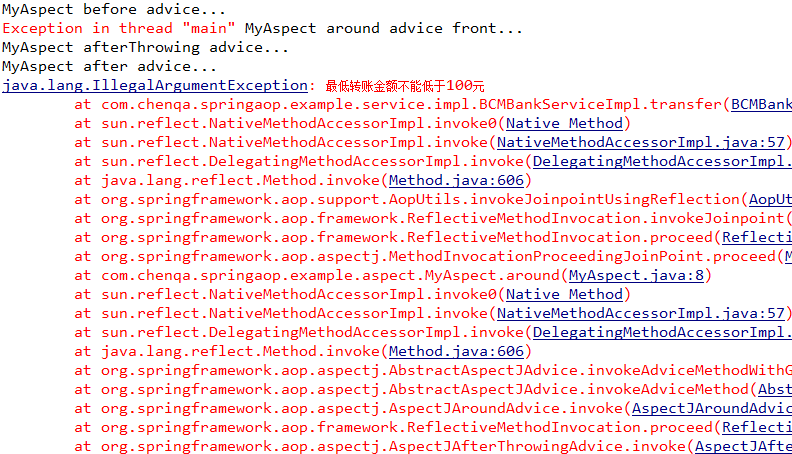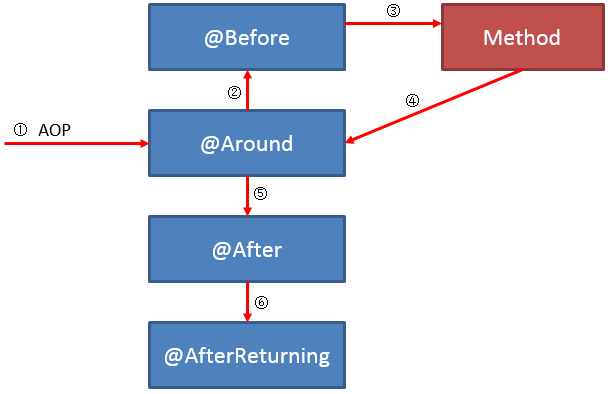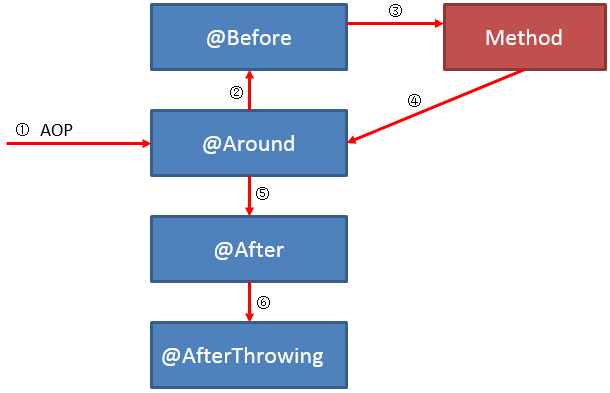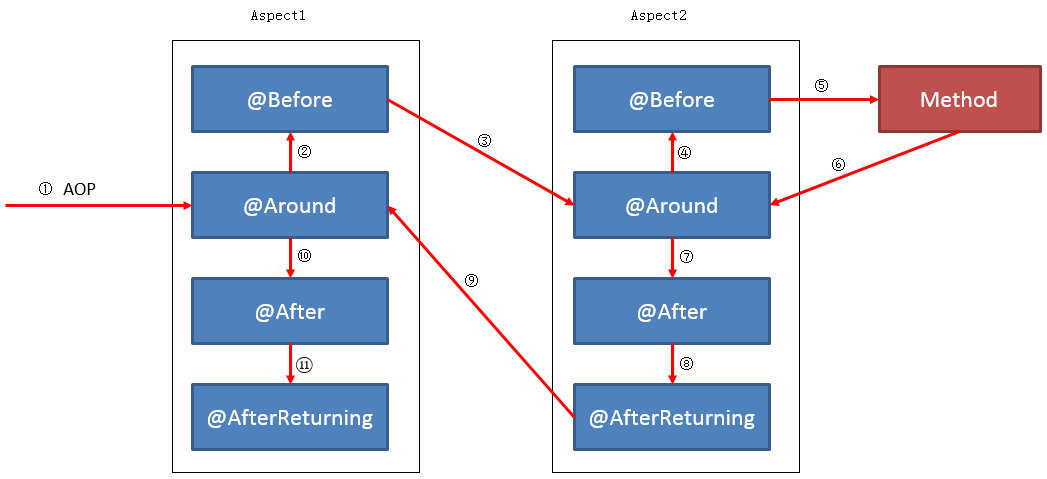spring aop 通知类型 浅谈spring aop的五种通知类型
C__joy 人气:0spring aop通知(advice)分成五类:
前置通知[Before advice]:在连接点前面执行,前置通知不会影响连接点的执行,除非此处抛出异常。
正常返回通知[After returning advice]:在连接点正常执行完成后执行,如果连接点抛出异常,则不会执行。
异常返回通知[After throwing advice]:在连接点抛出异常后执行。
返回通知[After (finally) advice]:在连接点执行完成后执行,不管是正常执行完成,还是抛出异常,都会执行返回通知中的内容。
环绕通知[Around advice]:环绕通知围绕在连接点前后,比如一个方法调用的前后。这是最强大的通知类型,能在方法调用前后自定义一些操作。
环绕通知还需要负责决定是继续处理join point(调用ProceedingJoinPoint的proceed方法)还是中断执行。
接下来通过编写示例程序来测试一下五种通知类型:
定义接口
package com.chenqa.springaop.example.service;
public interface BankService {
/**
* 模拟的银行转账
* @param from 出账人
* @param to 入账人
* @param account 转账金额
* @return
*/
public boolean transfer(String form, String to, double account);
}
编写实现类
package com.chenqa.springaop.example.service.impl;
import com.chenqa.springaop.example.service.BankService;
public class BCMBankServiceImpl implements BankService {
public boolean transfer(String form, String to, double account) {
if(account<100) {
throw new IllegalArgumentException("最低转账金额不能低于100元");
}
System.out.println(form+"向"+to+"交行账户转账"+account+"元");
return false;
}
}
修改spring配置文件,添加以下内容:
<!-- bankService bean -->
<bean id="bankService" class="com.chenqa.springaop.example.service.impl.BCMBankServiceImpl"/>
<!-- 切面 -->
<bean id="myAspect" class="com.chenqa.springaop.example.aspect.MyAspect"/>
<!-- aop配置 -->
<aop:config>
<aop:aspect ref="myAspect">
<aop:pointcut expression="execution(* com.chenqa.springaop.example.service.impl.*.*(..))" id="pointcut"/>
<aop:before method="before" pointcut-ref="pointcut"/>
<aop:after method="after" pointcut-ref="pointcut"/>
<aop:after-returning method="afterReturning" pointcut-ref="pointcut"/>
<aop:after-throwing method="afterThrowing" pointcut-ref="pointcut"/>
<aop:around method="around" pointcut-ref="pointcut"/>
</aop:aspect>
</aop:config>
编写测试程序
ApplicationContext context = new ClassPathXmlApplicationContext("spring-aop.xml");
BankService bankService = context.getBean("bankService", BankService.class);
bankService.transfer("张三", "李四", 200);
执行后输出:

将测试程序中的200改成50,再执行后输出:

通过测试结果可以看出,五种通知的执行顺序为:
前置通知→环绕通知→正常返回通知/异常返回通知→返回通知,可以多次执行来查看。
情况一: 一个方法只被一个Aspect类拦截
当一个方法只被一个Aspect拦截时,这个Aspect中的不同advice是按照怎样的顺序进行执行的呢?请看:
添加 PointCut类
该pointcut用来拦截test包下的所有类中的所有方法。
package test;
import org.aspectj.lang.annotation.Pointcut;
public class PointCuts {
@Pointcut(value = "within(test.*)")
public void aopDemo() {
}
}
添加Aspect类
该类中的advice将会用到上面的pointcut,使用方法请看各个advice的value属性。
package test;
import org.aspectj.lang.JoinPoint;
import org.aspectj.lang.ProceedingJoinPoint;
import org.aspectj.lang.annotation.*;
import org.springframework.stereotype.Component;
@Component
@Aspect
public class Aspect1 {
@Before(value = "test.PointCuts.aopDemo()")
public void before(JoinPoint joinPoint) {
System.out.println("[Aspect1] before advise");
}
@Around(value = "test.PointCuts.aopDemo()")
public void around(ProceedingJoinPoint pjp) throws Throwable{
System.out.println("[Aspect1] around advise 1");
pjp.proceed();
System.out.println("[Aspect1] around advise2");
}
@AfterReturning(value = "test.PointCuts.aopDemo()")
public void afterReturning(JoinPoint joinPoint) {
System.out.println("[Aspect1] afterReturning advise");
}
@AfterThrowing(value = "test.PointCuts.aopDemo()")
public void afterThrowing(JoinPoint joinPoint) {
System.out.println("[Aspect1] afterThrowing advise");
}
@After(value = "test.PointCuts.aopDemo()")
public void after(JoinPoint joinPoint) {
System.out.println("[Aspect1] after advise");
}
}
添加测试用Controller
添加一个用于测试的controller,这个controller中只有一个方法,但是它会根据参数值的不同,会作出不同的处理:一种是正常返回一个对象,一种是抛出异常(因为我们要测试@AfterThrowing这个advice)
package test;
import test.exception.TestException;
import org.springframework.http.HttpStatus;
import org.springframework.web.bind.annotation.*;
@RestController
@RequestMapping(value = "/aop")
public class AopTestController {
@ResponseStatus(HttpStatus.OK)
@RequestMapping(value = "/test", method = RequestMethod.GET)
public Result test(@RequestParam boolean throwException) {
// case 1
if (throwException) {
System.out.println("throw an exception");
throw new TestException("mock a server exception");
}
// case 2
System.out.println("test OK");
return new Result() {{
this.setId(111);
this.setName("mock a Result");
}};
}
public static class Result {
private int id;
private String name;
public int getId() {
return id;
}
public void setId(int id) {
this.id = id;
}
public String getName() {
return name;
}
public void setName(String name) {
this.name = name;
}
}
}
测试 正常情况
在浏览器直接输入以下的URL,回车:http://192.168.142.8:7070/aoptest/v1/aop/test?throwException=false1
我们会看到输出的结果是:
[Aspect1] around advise 1 [Aspect1] before advise test OK [Aspect1] around advise2 [Aspect1] after advise [Aspect1] afterReturning advise
测试 异常情况
在浏览器中直接输入以下的URL,回车:http://192.168.142.8:7070/aoptest/v1/aop/test?throwException=true1
我们会看到输出的结果是:
[Aspect1] around advise 1 [Aspect1] before advise throw an exception [Aspect1] after advise [Aspect1] afterThrowing advise
结论
在一个方法只被一个aspect类拦截时,aspect类内部的 advice 将按照以下的顺序进行执行:
正常情况:

异常情况:

情况二: 同一个方法被多个Aspect类拦截
此处举例为被两个aspect类拦截。
有些情况下,对于两个不同的aspect类,不管它们的advice使用的是同一个pointcut,还是不同的pointcut,都有可能导致同一个方法被多个aspect类拦截。那么,在这种情况下,这多个Aspect类中的advice又是按照怎样的顺序进行执行的呢?请看:
pointcut类保持不变
添加一个新的aspect类
package test;
import org.aspectj.lang.JoinPoint;
import org.aspectj.lang.ProceedingJoinPoint;
import org.aspectj.lang.annotation.*;
import org.springframework.stereotype.Component;
@Component
@Aspect
public class Aspect2 {
@Before(value = "test.PointCuts.aopDemo()")
public void before(JoinPoint joinPoint) {
System.out.println("[Aspect2] before advise");
}
@Around(value = "test.PointCuts.aopDemo()")
public void around(ProceedingJoinPoint pjp) throws Throwable{
System.out.println("[Aspect2] around advise 1");
pjp.proceed();
System.out.println("[Aspect2] around advise2");
}
@AfterReturning(value = "test.PointCuts.aopDemo()")
public void afterReturning(JoinPoint joinPoint) {
System.out.println("[Aspect2] afterReturning advise");
}
@AfterThrowing(value = "test.PointCuts.aopDemo()")
public void afterThrowing(JoinPoint joinPoint) {
System.out.println("[Aspect2] afterThrowing advise");
}
@After(value = "test.PointCuts.aopDemo()")
public void after(JoinPoint joinPoint) {
System.out.println("[Aspect2] after advise");
}
}
测试用Controller也不变
还是使用上面的那个Controller。但是现在 aspect1 和 aspect2 都会拦截该controller中的方法。
下面继续进行测试!
测试 正常情况
在浏览器直接输入以下的URL,回车:http://192.168.142.8:7070/aoptest/v1/aop/test?throwException=false1
我们会看到输出的结果是:
[Aspect2] around advise 1 [Aspect2] before advise [Aspect1] around advise 1 [Aspect1] before advise test OK [Aspect1] around advise2 [Aspect1] after advise [Aspect1] afterReturning advise [Aspect2] around advise2 [Aspect2] after advise [Aspect2] afterReturning advise
但是这个时候,我不能下定论说 aspect2 肯定就比 aspect1 先执行。
不信?你把服务务器重新启动一下,再试试,说不定你就会看到如下的执行结果:
[Aspect1] around advise 1 [Aspect1] before advise [Aspect2] around advise 1 [Aspect2] before advise test OK [Aspect2] around advise2 [Aspect2] after advise [Aspect2] afterReturning advise [Aspect1] around advise2 [Aspect1] after advise [Aspect1] afterReturning advise
也就是说,这种情况下, aspect1 和 aspect2 的执行顺序是未知的。那怎么解决呢?不急,下面会给出解决方案。
测试 异常情况
在浏览器中直接输入以下的URL,回车:http://192.168.142.8:7070/aoptest/v1/aop/test?throwException=true1
我们会看到输出的结果是:
[Aspect2] around advise 1 [Aspect2] before advise [Aspect1] around advise 1 [Aspect1] before advise throw an exception [Aspect1] after advise [Aspect1] afterThrowing advise [Aspect2] after advise [Aspect2] afterThrowing advise
同样地,如果把服务器重启,然后再测试的话,就可能会看到如下的结果:
[Aspect1] around advise 1 [Aspect1] before advise [Aspect2] around advise 1 [Aspect2] before advise throw an exception [Aspect2] after advise [Aspect2] afterThrowing advise [Aspect1] after advise [Aspect1] afterThrowing advise
也就是说,同样地,异常情况下, aspect1 和 aspect2 的执行顺序也是未定的。
那么在 情况二 下,如何指定每个 aspect 的执行顺序呢?
方法有两种:
- 实现org.springframework.core.Ordered接口,实现它的getOrder()方法
- 给aspect添加@Order注解,该注解全称为:org.springframework.core.annotation.Order
不管采用上面的哪种方法,都是值越小的 aspect 越先执行。
比如,我们为 apsect1 和 aspect2 分别添加 @Order 注解,如下:
@Order(5)
@Component
@Aspect
public class Aspect1 {
// ...
}
@Order(6)
@Component
@Aspect
public class Aspect2 {
// ...
}
这样修改之后,可保证不管在任何情况下, aspect1 中的 advice 总是比 aspect2 中的 advice 先执行。如下图所示:

注意点
如果在同一个 aspect 类中,针对同一个 pointcut,定义了两个相同的 advice(比如,定义了两个 @Before),那么这两个 advice 的执行顺序是无法确定的,哪怕你给这两个 advice 添加了 @Order 这个注解,也不行。这点切记。
对于@Around这个advice,不管它有没有返回值,但是必须要方法内部,调用一下 pjp.proceed();否则,Controller 中的接口将没有机会被执行,从而也导致了 @Before这个advice不会被触发。比如,我们假设正常情况下,执行顺序为”aspect2 -> apsect1 -> controller”,如果,我们把 aspect1中的@Around中的 pjp.proceed();给删掉,那么,我们看到的输出结果将是:
[Aspect2] around advise 1 [Aspect2] before advise [Aspect1] around advise 1 [Aspect1] around advise2 [Aspect1] after advise [Aspect1] afterReturning advise [Aspect2] around advise2 [Aspect2] after advise [Aspect2] afterReturning advise
从结果可以发现, Controller 中的 接口 未被执行,aspect1 中的 @Before advice 也未被执行。
以上就是本文的全部内容,希望对大家的学习有所帮助,也希望大家多多支持。
加载全部内容